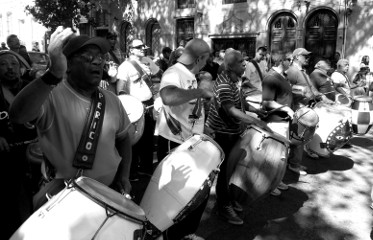Candombe is one of the most characteristic features of Uruguayan popular culture. It is practiced by thousands of people and its rhythm influenced and was incorporated into various genres of popular music. In 2009 it was inscribed on the Representative List of the Intangible Cultural Heritage of Humanity by UNESCO. Although originated in Uruguay, Candombe has its roots in the culture brought by the African slaves in the 18th century. It evolved during a long historical process, gradually integrating European immigrants and now permeating the whole society. Candombe drumming, with its distinctive rhythm, is the essential component of this tradition, that also includes dancing, symbolic characters and costumes. A detailed account of the historical, sociological and musical aspects of Candombe can be found in [Andrews 2010] and [Ferreira 2007].
The instrument of Candombe is called tambor (''drum'' in Spanish), of which there are three different sizes: chico (small), repique (medium) and piano (big). Each type has a distinctive sound (from high to low frequency range) and its own specific rhythmic pattern. All three are played with one hand hitting the skin bare and the other with a stick, which is also used to hit the shell when playing the clave or madera pattern. The minimal ensemble of drums (cuerda de tambores) must have at least one of each of the three drums; during a llamada de tambores it usually consists of around 20 to 60 drums. While marching, the players walk forward with short steps synchronized with the beat or tactus; this movement, while not audible, is very important for the embodiment of the rhythm. Figure on the right shows in the first row, from the front backwards, a repique, a chico and a piano.
